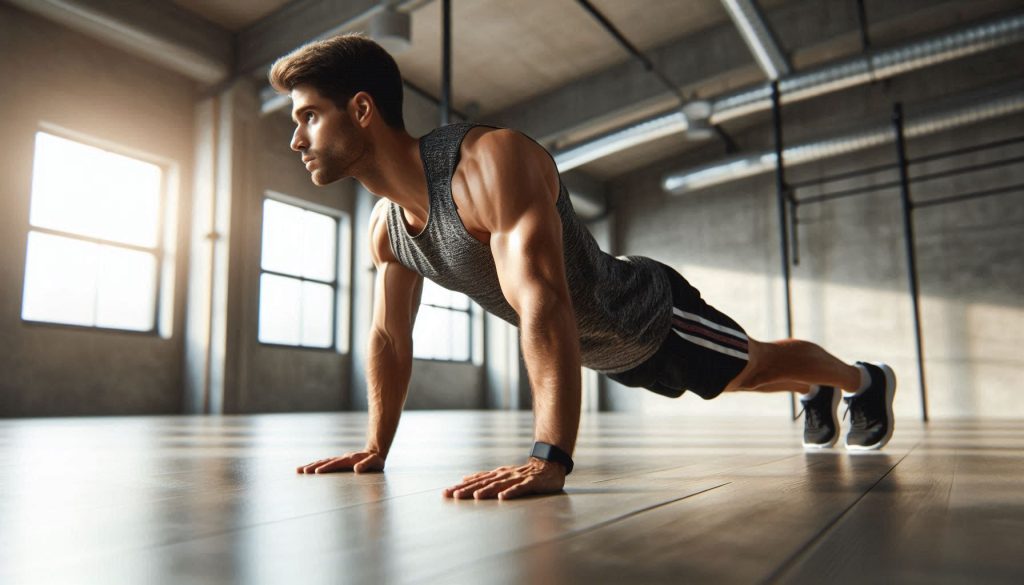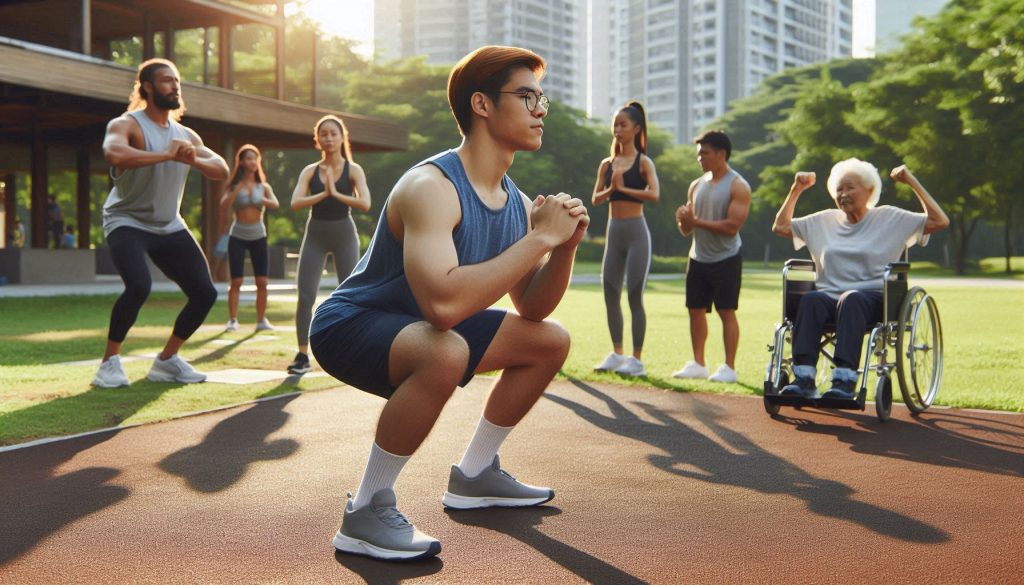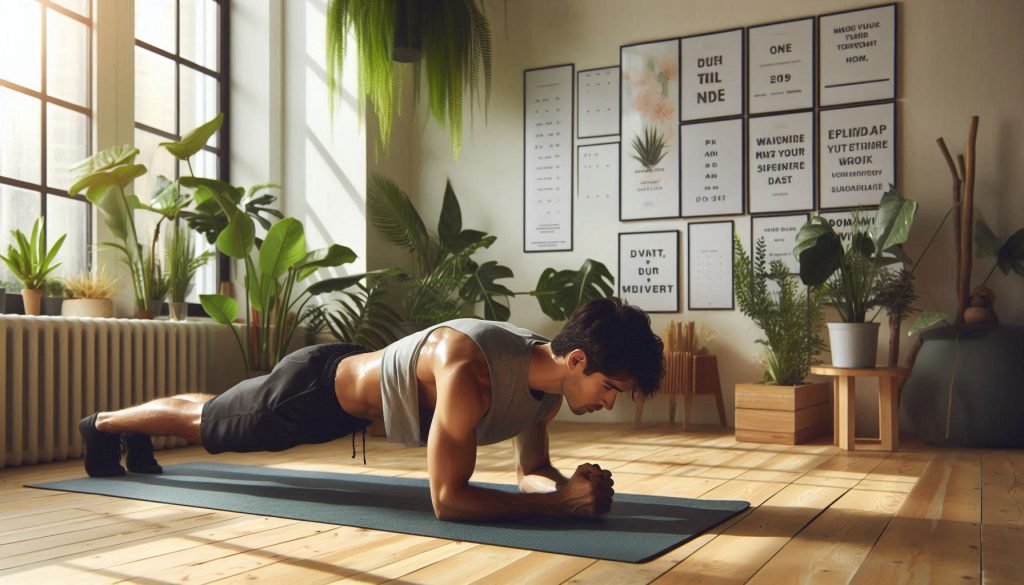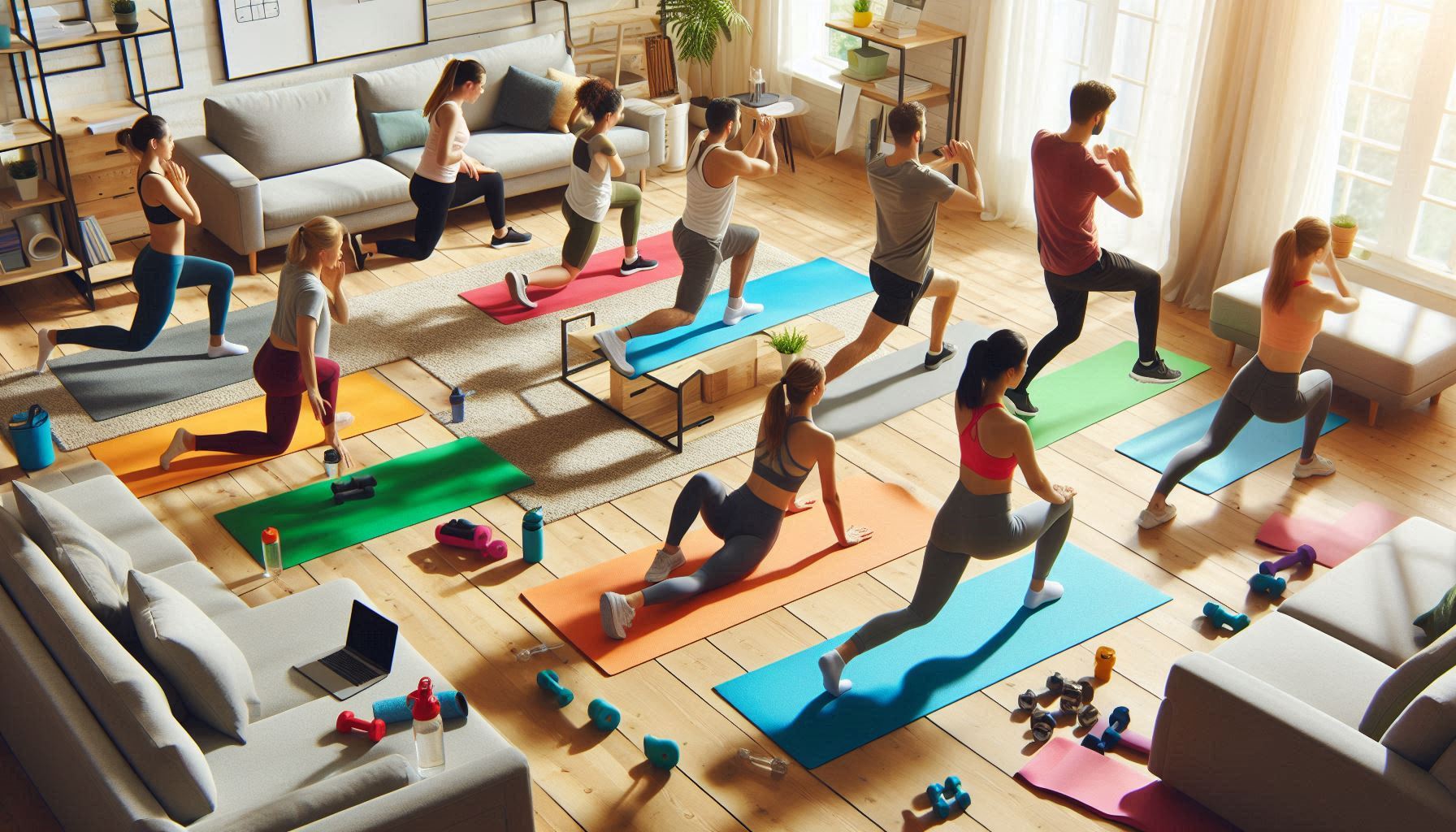Staying fit and active doesn’t necessitate a gym membership or expensive equipment. With the right selection of exercises, you can achieve an effective full-body workout from the comfort of your own home. Home workouts offer the flexibility to exercise at your convenience, eliminating the need for travel and allowing you to customize your routine to fit your schedule.
A comprehensive full-body workout engages multiple muscle groups simultaneously, promoting balanced strength and endurance. Exercises such as push-ups, squats, lunges, and planks are excellent for targeting various areas of the body without requiring any specialized equipment. These movements can be modified to suit different fitness levels, making them accessible for beginners and advanced athletes alike.
Additionally, home workouts can help you save time and money while still achieving your fitness goals. With consistent effort, you can enhance your physical health, improve functional strength, and even increase caloric burn. Ultimately, exercising at home empowers you to take charge of your fitness journey, making it both achievable and enjoyable. By incorporating a well-rounded routine, you can maintain an active lifestyle without the constraints of a gym.
The Importance of Full-Body Workouts
Full-body workouts are an efficient way to engage multiple muscle groups in a single session. Here are some key benefits:
- Time Efficiency: Full-body workouts target all major muscle groups at once, making them ideal for busy schedules. Instead of spending hours at the gym, you can get a complete workout in 30-45 minutes.
- Balanced Muscle Development: By engaging various muscle groups, you promote balanced strength and minimize the risk of muscle imbalances. This holistic approach ensures that no area is neglected, fostering overall physical health.
- Increased Caloric Burn: Working larger muscle groups results in higher calorie expenditure during and after workouts. This effect, known as excess post-exercise oxygen consumption (EPOC), can help with weight management and overall fitness goals.
- Functional Strength: Many full-body exercises mimic everyday movements, enhancing functional strength and stability. This transfer to real-life activities can improve performance in sports and daily tasks, making you more agile and capable.
Preparing for Your Workout
Before diving into exercises, it’s crucial to prepare your body and mind. Here are some steps to ensure you’re ready:
- Warm-Up: Start with 5-10 minutes of light cardio (e.g., jogging in place, jumping jacks) to gradually increase your heart rate and warm your muscles. Dynamic stretches such as arm circles and leg swings can also enhance flexibility and mobility.
- Space: Ensure you have ample room to move freely. Clear any obstacles or hazards from your workout area to avoid injury. A non-slip surface is ideal for performing various exercises.
- Hydration: Drink water before, during, and after your workout to stay hydrated. Proper hydration is essential for maintaining energy levels and optimizing performance. Consider keeping a water bottle nearby to remind yourself to drink regularly.
- Mindset: Set a positive intention for your workout. Whether your goal is to build strength, improve endurance, or simply enjoy the process, a focused mindset can significantly enhance your workout experience.
By understanding the importance of full-body workouts and adequately preparing yourself, you’re setting the stage for a successful and effective exercise routine. With the right mindset and preparation, you can enjoy the numerous benefits of staying active from the comfort of your home.
Essential Full-Body Exercises
Let’s explore essential exercises for a full-body workout, detailing how to perform each exercise correctly and highlighting their benefits.
1. Push-Ups
- Targets: Chest, shoulders, triceps, core.
- How to Do:
- Start in a plank position with your hands slightly wider than shoulder-width apart and feet together.
- Lower your body by bending your elbows until your chest nearly touches the ground.
- Keep your body in a straight line from head to heels.
- Push back up to the starting position.
- Benefits:
- Builds upper body strength.
- Engages the core for stability, promoting better posture.

- Variations:
- Knee Push-Ups: For beginners, perform push-ups on your knees to reduce difficulty.
- Decline Push-Ups: Elevate your feet on a bench or chair for a more challenging variation.
2. Squats
- Targets: Quads, hamstrings, glutes.
- How to Do:
- Stand with your feet shoulder-width apart and toes slightly pointed out.
- Lower your body by bending your knees and pushing your hips back, as if sitting in a chair.
- Keep your chest up and ensure your knees stay behind your toes.
- Return to standing by pushing through your heels.
- Benefits:
- Strengthens the lower body, including thighs and glutes.
- Improves flexibility in the hips and ankles, contributing to better overall mobility.

- Variations:
- Jump Squats: Add a jump as you rise for increased intensity and explosiveness.
- Sumo Squats: Widen your stance and point your toes outward for a different focus on inner thighs.
3. Lunges
- Targets: Quads, hamstrings, glutes.
- How to Do:
- Stand with feet together.
- Step forward with one leg and lower your hips until both knees are bent at about 90 degrees.
- Push back to the starting position and switch legs.
- Benefits:
- Enhances balance and coordination by engaging stabilizing muscles.
- Targets multiple muscle groups simultaneously for a more comprehensive workout.

- Variations:
- Reverse Lunges: Step back instead of forward to reduce knee strain and provide a different angle of engagement.
- Walking Lunges: Alternate legs while moving forward for continuous movement and added challenge.
4. Planks
- Targets: Core, shoulders, glutes.
- How to Do:
- Lie face down, then lift your body onto your forearms and toes.
- Keep your body in a straight line from head to heels.
- Hold for as long as possible, maintaining form throughout.
- Benefits:
- Strengthens the core, which is vital for overall stability and posture.
- Increases shoulder stability, helping to prevent injuries during upper body workouts.

- Variations:
- Plank with Arm Lift: Lift one arm in front of you while maintaining the plank position for added difficulty and core engagement.
- Side Plank: Shift to one side, supporting your body on one arm for oblique engagement.
5. Burpees
- Targets: Full body, cardio.
- How to Do:
- Start standing, then drop into a squat position.
- Kick your feet back into a plank position and do a push-up.
- Return to the squat position and jump up explosively.
- Benefits:
- Provides a high-intensity workout that boosts cardiovascular fitness.
- Engages multiple muscle groups, promoting overall strength and endurance.

- Variations:
- Half Burpees: Omit the push-up for a less intense version.
- Burpee with Tuck Jump: Add a tuck jump at the top for an extra challenge, increasing explosiveness.
6. Mountain Climbers
- Targets: Core, shoulders, legs.
- How to Do:
- Start in a plank position with your hands directly under your shoulders.
- Quickly bring one knee toward your chest, then switch legs in a running motion.
- Benefits:
- Great for cardiovascular fitness, elevating your heart rate effectively.
- Strengthens the core and lower body, enhancing agility and endurance.
- Variations:
- Slow Mountain Climbers: Move at a slower pace to focus on form and control.
- Cross-Body Mountain Climbers: Bring your knee toward the opposite elbow for additional core engagement and stability.
7. Glute Bridges
- Targets: Glutes, hamstrings, core.
- How to Do:
- Lie on your back with knees bent and feet flat on the floor, hip-width apart.
- Lift your hips toward the ceiling, squeezing your glutes at the top.
- Lower back down without touching the ground to maintain tension.
- Benefits:
- Strengthens the glutes and lower back, promoting better posture.
- Improves hip mobility, which is essential for overall movement efficiency.
- Variations:
- Single-Leg Glute Bridges: Lift one leg while performing the bridge for added difficulty and unilateral strength.
- Weighted Glute Bridges: Place a heavy object on your hips for resistance, intensifying the exercise.
8. Tricep Dips (Using a Chair)
- Targets: Triceps, shoulders, chest.
- How to Do:
- Sit on the edge of a sturdy chair, hands next to your hips.
- Slide off the chair, lowering your body by bending your elbows.
- Push back up to the starting position.
- Benefits:
- Isolates and strengthens the triceps, promoting upper body strength.
- Engages the shoulders and chest, improving overall upper body fitness.
- Variations:
- Bent Knee Dips: Keep your knees bent for a simpler version, making it more accessible for beginners.
- Straight Leg Dips: Extend your legs for added challenge, increasing the intensity of the exercise.
9. Bicycle Crunches
- Targets: Core, obliques.
- How to Do:
- Lie on your back with knees bent and hands behind your head.
- Lift your shoulders off the ground and bring one knee toward your chest while extending the other leg.
- Twist your torso to bring the opposite elbow toward the bent knee. Alternate sides.
- Benefits:
- Effectively targets the entire core, enhancing overall abdominal strength.
- Improves rotational strength, which is beneficial for athletic performance and daily activities.
- Variations:
- Slow Bicycle Crunches: Perform the movement slowly for better control and engagement.
- Weighted Bicycle Crunches: Hold a weight while performing the exercise for added resistance, increasing difficulty.
10. High Knees
- Targets: Cardio, legs.
- How to Do:
- Stand in place and run, bringing your knees up toward your chest as high as possible.
- Swing your arms for added momentum and balance.
- Benefits:
- Increases heart rate and improves cardiovascular fitness significantly.
- Engages the lower body muscles, promoting leg strength and endurance.
- Variations:
- High Knees with a Twist: Rotate your torso as you lift your knees for added core engagement and stability.
- High Knee March: For a lower-intensity version, march in place, bringing your knees high for a gentler workout.
Creating a Full-Body Workout Routine
Now that we’ve discussed essential exercises, here’s a sample full-body workout routine you can easily follow at home.
1. Warm-Up (5-10 minutes)
- Dynamic Stretching: Engage in arm circles, leg swings, and torso twists to increase mobility and prepare your muscles.
- Light Cardio: Incorporate activities like jogging in place or jumping jacks to elevate your heart rate.
2. Full-Body Workout Routine (30-45 minutes)
Perform each exercise for the specified repetitions, resting for 30-60 seconds between exercises. Repeat the circuit 2-4 times based on your fitness level.
- Push-Ups: 10-15 reps
Build upper body strength and engage your core. - Squats: 15-20 reps
Strengthen your legs and glutes while improving flexibility. - Lunges: 10-15 reps per leg
Enhance balance and coordination while targeting the lower body. - Plank: 30-60 seconds
Strengthen your core and improve stability. - Burpees: 8-12 reps
A full-body exercise that boosts cardiovascular fitness. - Mountain Climbers: 30 seconds
Engage your core and elevate your heart rate with this dynamic move. - Glute Bridges: 15-20 reps
Focus on strengthening your glutes and hamstrings. - Tricep Dips: 10-15 reps
Target your triceps and shoulders using a sturdy chair. - Bicycle Crunches: 15-20 reps per side
Engage your core and obliques effectively. - High Knees: 30 seconds
A cardio burst to finish strong, focusing on leg movement.
3. Cool Down (5-10 minutes)
- Static Stretching: Focus on major muscle groups, holding each stretch for 15-30 seconds to promote flexibility and recovery.
- Breathing Exercises: Practice deep, slow breaths to relax your body and mind.
4. Tips for Success
- Listen to Your Body: If you experience pain or discomfort, modify the exercise or take a break.
- Stay Consistent: Aim for at least three workouts per week for optimal results.
- Track Your Progress: Keep a journal of your workouts to monitor improvements and set new goals.
- Stay Motivated: Find a workout buddy or join an online fitness community for support and encouragement.
With dedication, you can effectively reach your fitness goals at home!
Conclusion
A full-body workout at home is not only accessible but also highly effective and versatile. By integrating essential exercises into your routine, you can enhance strength, boost endurance, and improve overall fitness without the need for a gym. Start each session with a proper warm-up to prepare your body, and don’t forget to stay hydrated throughout your workout. Key exercises like push-ups, squats, lunges, and planks engage multiple muscle groups, promoting balanced development and functional strength. These movements can be modified to suit your fitness level, ensuring that everyone can participate.
Listening to your body is crucial; if something feels uncomfortable, make adjustments or take breaks as needed. Aim for consistency by committing to at least three workouts a week and track your progress to stay motivated. With dedication and a structured approach, you can effectively reach your fitness goals from the comfort of your home. Embrace the journey, stay focused, and enjoy the numerous benefits of a well-rounded home workout routine!
SOURCES
Stephaine Mansour (2023) – 15 exercises for a full-body workout at home — no weights required
Stuart Marsh, (2016) – 10 full-body exercises: The workout you can do at home
Steve Kamb, (2023) – The 10 Best At-Home Workout Routines: The Ultimate Guide for Training Without a Gym
The Steel Library (2021) – 10 Best Full Body Exercises for Beginners
Healthline – 10 Exercises to Tone Every Inch of Your Body
HISTORY
Current Version
October 09, 2024
Written By:
SUMMIYAH MAHMOOD
